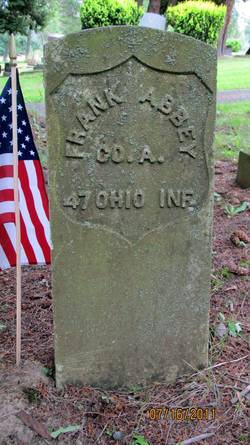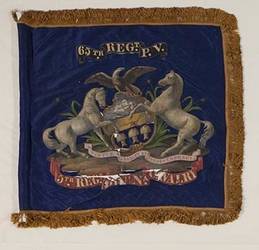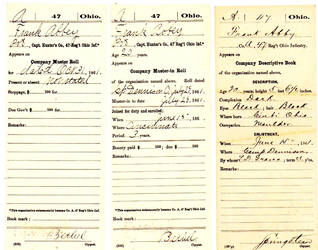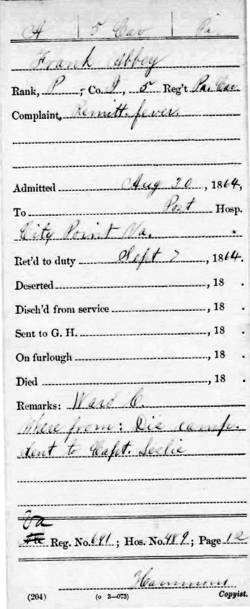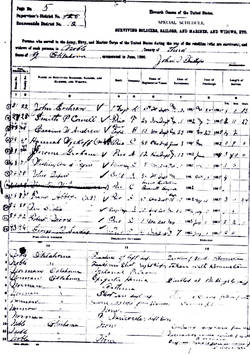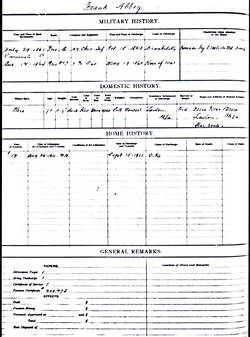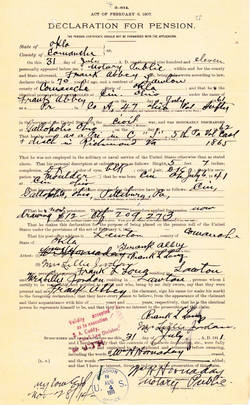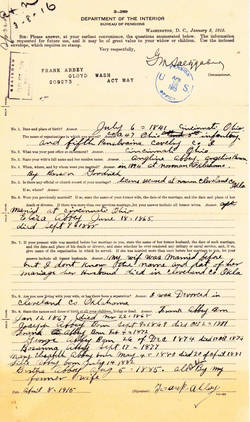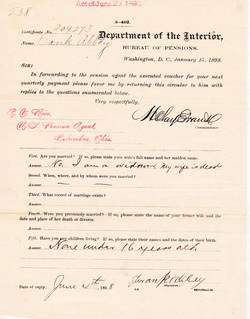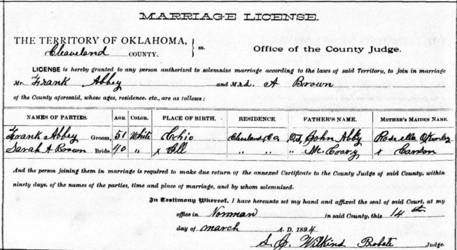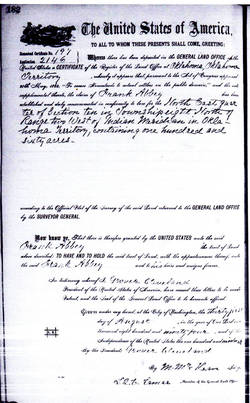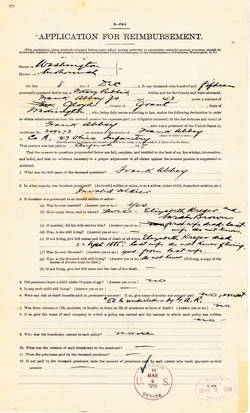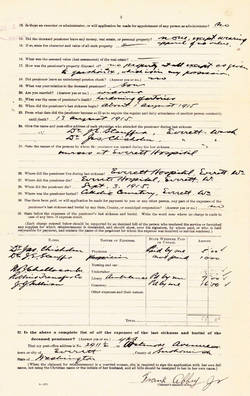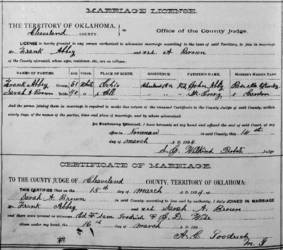Frank Abbey
Representing: Union
Unit History
- 47th Ohio Infantry A
- 5th Pennsylvania Cavalry Co. "U" & "I"
Full Unit History
47th OHIO VOLUNTEER INFANTRY
Organized: Summer, 1861 Camp Dennison Cincinnati Hamilton Co., OH
Mustered In: 8/27/61 Camp Dennison Cincinnati Hamilton Co., OH
Mustered Out: 8/11/65 Little Rock, AR
5th PENNSYLVANIA VOLUNTEER CAVALRY
Organized: Spring & Summer, 1861 Philadelphia & Pittsburg, PA
Mustered In: 9/1/61 Philadelphia, PA
Mustered Out: 8/7/65 Richmond, VA
Regimental History
REGIMENTAL HISTORY: (47th)
The 47th, a three year western theater regiment was formed during the summer of 1861. The day following Federal muster it left Ohio by rail for western Virginia. There, it participated in the battle of Carnifix ferry (9/10) before going into winter quarters at Tompkin’s farm, Gauley mountain.
In the spring of 1862 a portion of the regiment was sent on an expedition to Lewisburg, VA. The movement proved a complete success, the enemy being routed and scattered. The unit then spent the remainder of the year in Virginia engaged in various duties.
1863. The new year found the 47th joining the Union effort to capture Vicksburg, MS. During the latter part of May the regiment led an impetuous charge against Cemetery Hill. Although a foothold was gained close to the enemy works, the position which had been taken with severe loss, had to be abandoned. Another charge a few days later concluded with the same unsatisfactory result. The 47th then occupied Cemetery Hill fort until the surrender of the city on 7/4/63.
The year 1864 opened with the 47th being transferred to eastern Tennessee. After reenlistments and veteran volunteer furloughs the regiment returned to the field with the forces of Union Gen. William T. Sherman as they moved toward Atlanta, GA. The unit met the enemy at Resaca, Dallas, Kennesaw Mtn. and during Confed. Gen. Hood's dash to the rear of Sherman's armies. With the fall of Atlanta the 47th participated in the march to the sea. During the early months of 1865 the regiment marched with Federal forces northward through the Carolinas. It was mustered out of existence on 8/11/65.
REGIMENTAL HISTORY: (5th)
The 65th Pennsylvania infantry or 5th cavalry, an eastern theater regiment was one of the first three year regiments formed. Known as the Cameron Dragoons, ten of its companies were recruited in the Philadelphia area while another two were raised in Pittsburg. As initially configured, the regiment was composed of many officers and men of the Jewish faith.
On 8/22/61 the Philadelphia companies departed that city for Washington, D.C. A few days later companies "L" and "M" moved there from Pittsburg. The unit concluded the year scouting and garrisoning Lewisville, VA, now part of West Virginia.
During the Virginia Peninsula campaign during the spring of 1862 the 5th was primarily employed in scouting duties, but on 9/9, near Williamsburg, it was attacked by a superior force of the enemy and suffered a loss of 6 killed, 15 wounded and 33 captured. It was then much further reduced in numbers by sickness and additional casualties. Recruits received in November and December once again swelled regimental ranks.
1863. During that winter detachments of the regiment were utilized on scouting duty around the Williamsburg area. These sorties added to the regimental casualty list. Losses continued during a 3/29 Rebel attempt to capture Williamsburg and an April attack by other Confederate forces. The 5th experienced little activity of interest during the summer months of '63, but continued to suffer losses from sickness until winter set in.
In February and March, 1864 the 5th received 231 new recruits. In May it participated in a raid on the Weldon Railroad after which it proceeded to Bermuda Hundred, VA. From there it moved to City Point, VA and joined Union Gen. Benjamin Butler's forces across the Appomattox River. There, it was dismounted and moved into the trenches before Petersburg with other "cavalry" units.
The 65th retired from the trenches after 6/9 when it and others made a "gallant" assault on the enemy's fortifications. The unit shared in another such assault on the 22nd with considerable loss. It then participated in Wilson's raid against the Southside and Danville railroads. During battles that followed the 5th lost heavily in men and horses.
The Union's October engagement at New Market cost the regiment nearly one half its effective strength. Smaller losses were incurred during two late year actions along the Charles City road.
In latter March, 1865 the 5th joined Union Gen. William T. Sheridan's command and on April 1st started on its last campaign. The enemy was met and routed at Five Forks (4/1/65). There the regiment captured 300 prisoners. During Confed. Gen. Robert E. Lee's subsequent movement from Petersburg toward Appomattox Court House the 5th continued to be active. On 4/7 it reached Appomattox where it shared in the fighting up until the April 9th surrender of Lee's Army of Northern Virginia. The regiment then remained in Virginia until mustered out of the U.S. Army and into history.
Soldier History
SOLDIER: (47th)
Residence: Cincinnati Hamilton Co., OH Age: 19.11 yrs.
Enlisted/Enrolled: 6/15/61 Cincinnati Hamilton Co., OH Rank: Pvt.
Mustered In: 7/29/61 Camp Dennison Cincinnati Hamilton Co., OH
Discharged For Medical Disability: 10/18/62 Gallipolis, OH
Highest Rank: Pvt.
SOLDIER: (5th)
Residence: Sharpsburg Alleghany Co., PA Age: 23.1 yrs.
Enlisted/Enrolled: 8/12/64 Philadelphia, PA Rank: Pvt.
Mustered In: 8/12/64 Philadelphia, PA
Mustered Out: 5/19/65 Richmond, VA
Highest Rank: Pvt.
Family History
PERSONAL/FAMILY HISTORY:
Frank A. - although not found documentally, the A. likely represented Ambrose or Ambroes - Abbey was born July 6, 1841 in or near the City of Cincinnati Hamilton County, Ohio. His parents were John (no b.d.) and Rose Ella "Rosy" (nee Okerley b. 1799/1800.) Abbey. While at one point Frank would indicate his parents were from France, a preponderance of evidence points to their both being born in Germany. When John and Rose Ella had come to America and whether or not they came as a married couple is not known. Further, the Abbey family cannot be located in either the 1840 or 1850 U.S. Census tallies, so John's occupation is not documented. But, according to family sources, he was a "laborer." By 1860 when the next census was taken, he was out of the family picture having died.
According to the 1860 census we know Frank had at least two older sibling: Barbara (b. 1836 OH) and Joseph (b. 1839 OH). He also had at least one younger sibling: Belshazar (b. 1850 OH).
In 1860 Barbara, Joseph and Frank were living with their mother in Cincinnati. Barbara's occupation was listed as seamstress while both Joseph and Frank were tagged as engineers. No details are documented pertaining to the engineer designation. Strangely, Belshazar does not appear in the '60 or '70 tallies, but does appear in the one for 1880.
On June 15, 1861 at Camp Dennison, Cincinnati, OH Frank enlisted in the U.S. Army for three years. [1] His unit of service was Captain Hunter's Company of the 47th Ohio infantry. Hunter's organization would initially be designated as company "C" of the 47th, but would, by March/April, 1862, become company "A" of that regimental unit.
At enlistment Private Abbey's vital statistics were listed as follows: Age = 20 (19.11) yrs.; Height = 5' 6 1/2"; Complexion = dark; Hair = black and Eyes = black. His occupation was noted as "moulder" (molder). While no details are presented pertaining to the duties of a "moulder" (molder), likely they were connected to some industrial hot metal or other liquefied casting process.
Private Abbey's time with the 47th would start out with his being absent from his unit. In November/December, 1861 that absence was because of a furlough. In January/February, 1862 it would be because of some undocumented illness which hospitalized him for a time. Present for duty in March of '62 he remained so until the occurrence of an accident which would lead to his being medically discharged from the military.
The accident referred to occurred in West Virginia sometime between August 6 and August 10, 1862. It involved the following scenario. while stationed between Tompkin's Farm and Lewisburg, Private Abbey was sent out, with others, on a night scouting patrol. The scout required crossing the Greenbrier River on a log that had either naturally fallen or had been felled across the waterway to create a pathway. Bark had been stripped from the log which made it slippery. To make matters worse, it had been raining. During the crossing Private Abbey slipped and fell, thereby straddling the log and ruptering or otherwise injuring his left testicle. The injury resulted in his first being treated in the regimental hospital at Tompkin's farm , but by 8/25 he had been admitted to the Ganley Bridge post hospital located in Charleston, (West) Virginia with a diagnosis of varicocele, an enlargement of the blood vessels in the scrotum. His condition not improving, from there our private was transferred to the U.S. General hospital located in Gallipolis, OH. There he was characterized as having been unfit for the duties of a soldier for sixty or more days and given a medical discharge from the army. That discharge was effective 10/18/62 with his departure from the hospital occurring on 10/21/62.
Exactly where Frank went to live after his military discharge is not known. In fact, his whereabouts are not documented from October, 1862 throughout 1863 and into 1864 when, on 8/12/64 in Pittsburg, PA he again enlisted in the military. This time, though, he was going to ride, not walk. For this enlistment his unit of choice was the 5th Pennsylvania cavalry. At first not assigned to any company, he was, shortly after Federal muster, assigned to Company "I'. Residing at the time in the borough of Sharpsburg located in Alleghany County, PA his enlistment was credited to that community and its corresponding congressional district. For his one year enlistment, Private Abbey received a $100 enlistment bounty, $33.33 of which was paid to him almost immediately.
While serving in the Pennsylvania 5th, Private Abbey's surname sometimes was written Abby. Further, his name also appeared on several company muster rolls with the middle initial P. Enlistment papers signed by Frank, however, reflect no such middle initial or any middle initial at all. Upon further examination of company present/absent documents it appears a company scribe may have erroneously added the P after Frank when the capitalized letter, the first of the word Pittsburgh written below his name, showed up on one of the forms stretching up between Frank and Abbey.
On 8/30/64, after his enlistment, but before joining his new regiment, Private Abbey wound up in the post hospital at City Point, VA. The reason for his hospitalization was “remittent fever.” On 9/7 he was returned to duty and forwarded to the 5th.
After joining his regiment and company on September 8th, Private Abbey was thereafter noted as being present for duty the remainder of his hitch. There was, however, a period of "detached service" starting in late September and apparently lasting into late November. As with his hospitalization, the nature of this service is not documented.
Mustered out of the cavalry on 5/19/65 it appears Frank returned to Cincinnati. Shortly thereafter, on 6/18/65 he married to Elizabeth "Elisa" Kreger (b. 1848 OH). [Note: In one instance Elizabeth’s surname appears as Swartz. Where this came from is not known.] How and when the two had met is not documented. On 1/12/67 the couples' first child, son Frank (no m.i.), was born. According to one set of numbers, Frank died the following year on 11/22/68. In the 1870 census, however, he was listed as being three years old at the time of that accounting. He obviously died, however, prior to 2/4/72 as that was when a third son was born and also christened Frank: Frank Ambroes (Jr). The first Frank would not be the only child lost to the Abbeys.
Here it should be noted that between the birth of son Frank and Frank Ambroes, Jr. another son had joined the Abbey family. That male child born on 9/9/69 (OH) was christened Joseph, likely in honor of Frank's older brother.
1870. A new decade. A new beginning. The painful and bloody '60s were gone, but surely not forgotten...........
The census for the debut year of the '70s found the Abbey family still residing in Cincinnati with the household consisting of Frank, Elizabeth, Frank Ambroes and Joseph. The only thing new we really learn from the census is that the family's patriarch was, in fact, employed making molds for cast parts, at the time they being identified as for iron stoves.
The 1870s would see former Civil War soldier Frank Abbey initiate the paperwork process necessary to seek U.S. Government disability pension based on ailments an injuries which traced back to his soldiering days. As best as can be determined this process was begun around September of 1874 with focus on the scrotum/testicle injury received while serving in the infantry. According to available documents, the old war injury continued to bring pain to his groin and genitalia when walking, etc. A stipend would ultimately be granted, but it would be some years in coming. More on this later.
All the while Frank sought pension relief for his bodily sufferings, he and Elizabeth continued to add to their family. On 12/26/74 son George was born. Unfortunately George died less than two years later on 10/17/76. Daughter Rosanna "Rosa" was next to join the household. She came into this world on 9/17/44 (OH). On 5/4/80 came Mary Elizabeth (OH). The census of that same year found the Abbeys still residing in Cincinnati. Under Frank's roof at the time were he, wife Elizabeth and children Joseph, Frank A., Rosa and Mary.
Still an infant, daughter Mary Elizabeth died on 4/20/81. Her older brother, Joseph, followed her in death on 10/2 of that same year.
Daughter Lilie/Lily L. was born on 7/14/82 (OH) while last to join the Abbey household was daughter Bertha born on 8/5/85. By that date the Abbeys had quitted Ohio for a new stake in Leavenworth, Kansas. Again, the lure of Kansas over Ohio is not documented, but it was likely the availability of new farm land.
1885 proved to be sweet, yet bitter for the Abbeys. As noted, by the time of a mid-year, or earlier, local census, they had quitted Ohio and were residing in Leavenworth, Kansas. There, Frank once more listed his occupation as "engineer." As mentioned earlier, the year was sweetened by the 8/5 birth of daughter Bertha, the Abbey's final child. It was made bitter when, on 9/22 close on the heels of the new child's birth, her mother, Elizabeth, died. While cause of the family matriarch's death is not documented, coming as it did so closely following the birth of Bertha, it was likely connected with childbirth complications. Where Elizabeth was buried is not known.
If available records are to be relied upon as factual, by mid-1886, less than a year after his wife's death, Frank - and presumably his family - were back in Cincinnati. When, exactly the move came about is not known. As for a why, it was likely his returning to familiar territory and friends during his time of loss. Whatever the reason, by this time he has been granted a governmental pension stipend of $2 per month because of varicocele of his left side stemming from the log incident.
As noted above, it seems possible the Abbeys moved back to Ohio so Frank and family could regroup following the death of Elizabeth. If that was the case, he regrouped rather quickly as is evidenced by the fact that as of 8/19/90 he had removed from Ohio to Oklahoma. On 8/19/90 his first Oklahoma address was Norman in County #3 [later Cleveland County] of that territory which on 4/22/1889 had been newly opened for homestead settlement. A short time later a Civil War veterans census placed him in nearby Noble, also in #3/Cleveland County. His community of residence would remain Noble until sometime between 1900 and 1910.
On 3/15/94 in Norman Cleveland co., OK. Frank remarried. His new bride was the previously married/widowed Sarah Angeline Brown (No b.d. No nee). The marriage, however, did not work out. While no date is available, at some point between the marriage year and 1900 the couple divorced. Cleveland county records pertaining to such matters were reportedly destroyed by fire in 1904
On 4/22/89 Frank and his three children settled on a tract of prairie land, a small portion of which was timbered. The 160 acres were located near present day Norman, Oklahoma. There he dug one or more wells and began construction on a dwelling which he and family occupied around mid-May.
Over the next five years Frank – absent only few days at a time for business purposes - and his children worked the homestead claim. Beyond a house, other structures including a barn and “dugouts” were constructed. Additionally, one and one quarter mile of the property was fenced and fifty five to sixty acres which were cleared for planting ground crops and an orchard. On 8/19/94 Frank received the patent (deed) to his homestead acreage.
The census of 1900 found widower Frank along with son Frank A. and daughter Lilie farming in Noble Cleveland Co., Oklahoma. A decade later, however, Frank had moved to Everett, Snohomish County located in western Washington. An old story is here retold, what had drawn him to the Puget Sound area is not known. In Everett he was noted as a "restaurant keeper." Living with him at the time was a man named Arthur Woirt who was employed in a local livery stable.
One year later, in 1911, Frank was no longer in Washington. By that time he had removed from The Evergreen State to either Lawton Comanche Co., OK or back to Leavenworth, Kansas. Available records are very unclear on the situation. What is clear is that by 1911 Frank's pension stipend had been upped to $12 per month.
Whether or not it was Frank living in Oklahoma or Kansas in 1911, by June 6, 1912 he was in neither, but residing in Coarsegold Madera County, California. The California stay lasted three years at the most as by 4/2/15 he was living back in Washington State with son Frank A. in the small, eastern Washington Grant County community of Gloyd. It was to this address that his last government disability payment - now $23 per month - was mailed.
While Gloyd may have been our Frank’s “permanent" address, by August 11th of ‘15 he was back in Everett living/staying at 2007 1/2 Hewitt. We know this because, with his health failing it appears that was the date our old soldier was transported from this address via ambulance to the local hospital. There he would die on 9/3/15. Cause of death for the 74.1 year old was listed as pneumonia and arteriosclerosis. With the local G.A. R. post paying the $50 undertaker fee, burial was on 9/6 at Everett’s Mt. Carmel Catholic cemetery.
**************************************************************************************************
Prolog: In March of 1916 because his father owned nothing of value- only his personal clothing - at death, son Frank , Jr. needing the money, petitioned the U.S. Government for reimbursement of $105 expended for his father's end of life hospital expenses, funeral expenses, etc. The request was denied because no documentation could be provided in conjunction with divorcing from the second wife or her fate.
[1] Frank's older brother, Joseph, did not volunteer to serve in the U.S. military during the American Civil War. Although his name appeared in the 1863-1865 Ohio listing for men eligible to be drafted, to all indications, he was never called up.
Cemetery
Buried at Mt Carmel Cemetary
